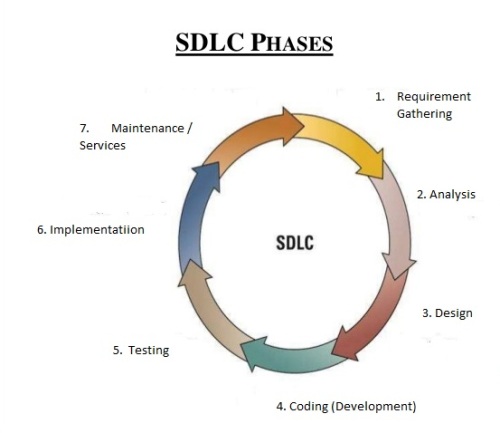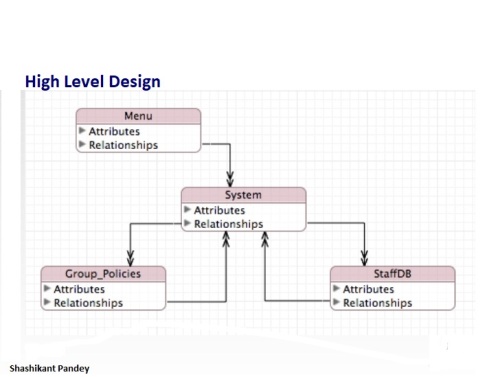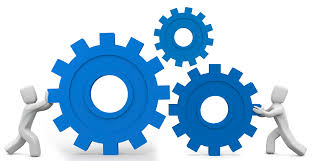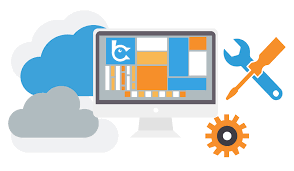SDLC (Software Development Life cycle)
A Software development life cycle is composed of a number of clearly defined and distinct work phases which are used by Software engineers and Software developers to plan for, design, build, test, and deliver Software. Like anything that is developed on an assembly line, an SDLC aims to produce high-quality software that meet or exceed customer expectations, based on customer requirements, by delivering software which move through each clearly defined phase, within scheduled time frames and cost estimates.
The SDLC is not a methodology, but rather a description of the phases in the life cycle of a software application. These phases (speaking) are
- Requirement Gathering
- Analysis
- Design
- Coding (Development)
- Testing
- Implementatiion
- Maintenance / Services

Requirement Gathering
In this Phase, Business Analyst will gather the all requirement from the client/customer and prepare Business requirement specification (BRS) or Customer requirement specification (CRS) or User Requirement Specification (URS). Senior business Analyst will prepare the System/Software requirement Specification (SRS) documents.
Rule for Successful requirement gathering
- Always Ask – don’t assume you know what user wants.
- Include the users from the starting.
- Define and agree on the scope of the project.
- Requirement should be SMART – specific, Measurable, Agree upon, Realistic and Time-based.
- Gain clarity if there is any doubt.
- Create clear user requirement document and share with the customer (play them back).
- Avoid talking about technology or solutions until the requirements are fully understood.
- Get the requirements agreed with the stakeholders before the project starts.
- Create a prototype model, if necessary, to confirm or refine the customer’s requirements.
Analysis
It is a method that allows the analyst to understand the system and its activities in a logical way. It is a systematic approach to analyse and refine the existing system and develop a new system specification which can be easily understandable by user.
Note: –The features and the functions that need to be put in the project are determined/analysed.
Design
It will be done by the very experienced person like Chief Architect or technical Team Leader or Architect.
Architect will have prepared the HLD (High Level design) and LLD (Low Level Design).
HLD: – High Level Design
- List of modules and a brief description of each module.
- Brief functionality of each module.
- Interface relationship among modules
- Database tables identified along with the key element.
- Overall architecture diagrams along with technology details.
Example1.1: Data flow diagram for high level design
LLD: – Low Level Design
- Detailed functional logic of the module.
- Database table, with all elements, including their type and size.
- All dependency issue Error Message Listings.
- Complete input and Output for a module.
Example1.2: Data flow diagram for high level design
Development/Coding
Based on the HLD and LLD document, small modules are summed together and developed.

Testing
If testing is done correctly, it increases the overall software quality. This phase done by Test Engineers. Different types of testing performed by test engineers.
- Functional Testing and Non-Functional Testing.
- Black-Box Testing and White-Box Testing.
- Static & Dynamic Testing
- Unit testing
- System testing
- Performance Testing
- Load Testing

Implementation

The Implementation phase is when the end user of your software is foremost in your mind. During this phase, you create the documentation and tools the customer uses to make informed decisions about how to deploy your software securely. To this end, the Implementation phase is when you establish development best practices to detect and remove security and privacy issues early in the development cycle.
Maintenance

The Maintenance Phase occurs once the system is operational. It includes implementation of changes that software might undergo over a period of time, or implementation of new requirements after the software is deployed at the customer location. The maintenance phase also includes handling the residual errors that may exist in the software even after the testing phase. This phase also monitors system performance, rectifies bugs and requested changes are made.
A Maintenance, often turned support, is a crucial activity for linking the experiences of users/customers with the product delivery organization. We consider perspectives on high tech maintenance from bug fixing through to design focused activities.
Key Deliverables:
- Keep system live
- Maintain code
- Update software when required
Sources: –
https://eternalsunshineoftheismind.wordpress.com/2013/03/10/sdlc-phase-5-maintenance/
https://www.projectsmart.co.uk/requirements-gathering.php
September 24, 2017 at 11:47 pm
[…] via SDLC (Software Development Life cycle) — PandeyCRM […]
LikeLike
September 25, 2017 at 9:18 pm
Awesome……well explained
LikeLike